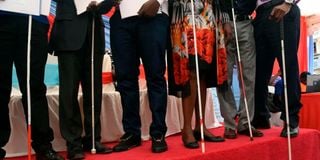One million Kenyans living with disabilities in need of assistive devices

Visually impaired persons holding their white cans during the White Cane Day at the Kabete Orthopedic Grounds in Nairobi.
What you need to know:
- The objective of World AT Day is to bring together all relevant sectors such as health, education, social services, development and the private sector.
- The day serves as a platform for users of AT to voice their experiences — both the barriers they face and the benefits they derive from access.
One million Kenyans living with disabilities are in dire need of assistive technology (AT), Richard Bosire, the deputy director, Social Development, at the Ministry of Labour says.
AT refers to assistive products such as wheelchairs, eye glasses, hearing aids, artificial limbs and digital devices and their related systems and services that enable people to move, communicate and see better.
These products enable people to live healthier and more independent lives, working, studying and enjoying everyday moments that many may take for granted.
While urging the country to invest more in AT during the world’s first-ever Assistive Technology Day on June 4, the deputy director highlighted that innovative solutions and successful implementation will make a significant impact on the lives of individuals with disabilities and those in need of AT.
“As you are aware, there are currently around one million individuals in Kenya who require rehabilitative and assistive technology services, but are unable to access them due to various challenges,” he observed.
Mr Bosire explained that the objective of World AT Day is to bring together all relevant sectors such as health, education, social services, development and the private sector.
He noted that the day serves as a platform for users of AT to voice their experiences — both the barriers they face and the benefits they derive from access.
“By listening to these stories, we can better appreciate the importance of assistive technology and advocate for policies and practices that enhance accessibility,” he said.
“We urge all stakeholders, including government agencies, non-governmental organisations, healthcare providers, educators and the private sector to allocate more resources towards the development and distribution of assistive technology, conduct training for healthcare providers and awareness campaigns for the public about the importance and availability of assistive technology, develop supportive policies and foster innovation,” Mr Bosire sad
The commemoration comes after last year, the Ministry of Health launched the rehabilitative services and assistive technology strategy 2022-2026, disability medical assessment and categorisation guidelines 2022, and the ATscale Project.
According to the ministry, AT is most needed by older people, children and adults with disabilities as well as people with long term health conditions such as diabetes, stroke and dementia.
The Health ministry points out that the number of Kenyans living with disabilities is increasing.
“It is estimated that 0.9 million or 2.2 per cent of the population have a disability, which requires extensive healthcare services.”
The ATscale project is a three-year project geared towards supporting capacity building, strengthening supply chain for assistive technology, sustainable financing and development of policy and guidelines.
It aims at strengthening local capacity to produce, enhancing infrastructure, data and systems, enhancing demand generation and programme coordination. It is being executed in collaborated with Clinton Health Access Initiative .
Last year, Dr Zeinab Gura, acting director, Health Care Services at the Health ministry, explained that there are significant gaps facing the provision of rehabilitative services, which the ministry aims to prioritise through reviewing the harmonised benefit package to include the rehabilitation package, developing the list of essential assistive technology, and streamlining the training of human resources for rehabilitation services.
Dr Gura disclosed that the ministry’s strategy aims to increase access to care up to the primary health care and community levels by developing infrastructure, building human resource capacity, and providing equipment needed for rehabilitation services.
The strategy also envisions strengthening the Community Based Rehabilitation for early identification of disabilities and rehabilitation at the community level.
The guidelines, the director said, will ensure the appropriate and timely identification and categorisation of disabilities.
“The ministry is committed to providing oversight and guidance to the ATscale project to ensure its success,” the director assured.
The World Health Organization (WHO) observes that globally, more than 2.5 billion people need one or more assistive products.
With an ageing global population and a rise in non-communicable diseases, an estimated 3.5 billion people will need assistive technology by 2050.
“Improving access to assistive technology can contribute to the achievement of the Sustainable Development Goals and ensuring that no one is left behind.This is through enabling the inclusion and participation of assistive technology users in their family, community and all areas of society, including the political, economic and social spheres,” WHO notes adding that in many countries, most people who need assistive technology do not have access to it.
The WHO and UNICEF global report on assistive technology demonstrates considerable inequity in access to assistive technology.
“As few as three per cent of people in some low-income countries were reported to have access to the assistive products they need, in comparison to 90 per cent in some high-income countries.”
The report discloses that of the 80 million people who need a wheelchair, only five to 35 per cent will have access to one depending on the country in which they live.
On hearing, globally, 1.5 billion people have hearing loss, yet hearing aid production currently meets less than 10 per cent of the global demand.
This, according to the findings, means that unaddressed hearing loss across the globe leads to an annual cost of $980 billion.
“The 2030 Agenda for Sustainable Development places good health and well-being at the centre of a new development vision. It emphasises universal health coverage to ensure sustainable development for all so that everyone can access the health services needed without financial hardship,”the global health authority states.





